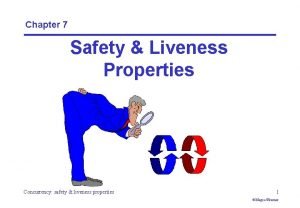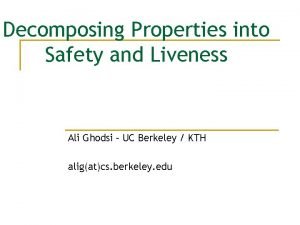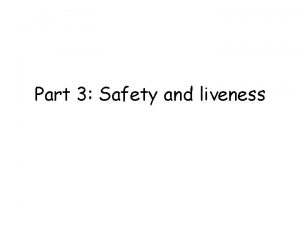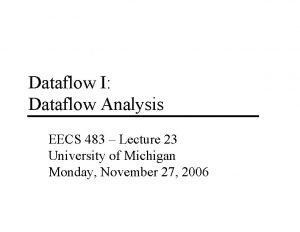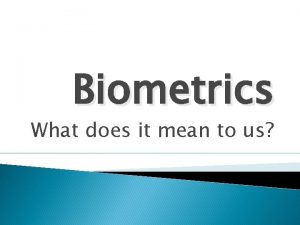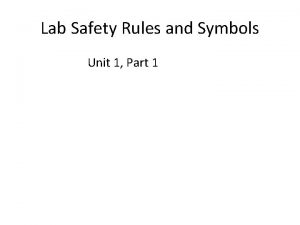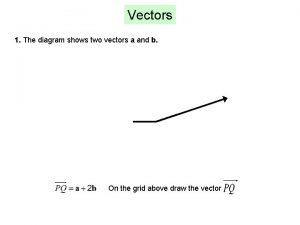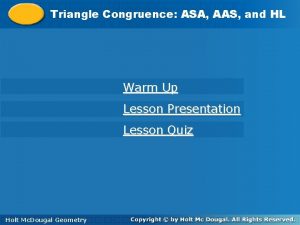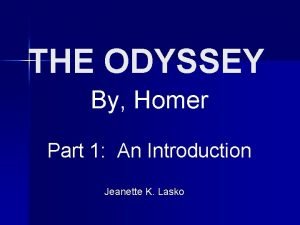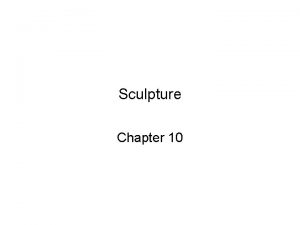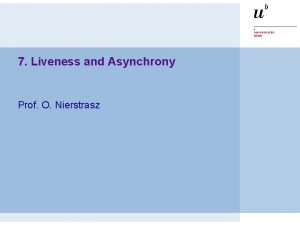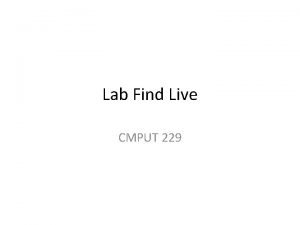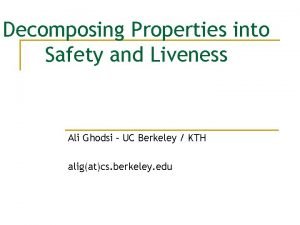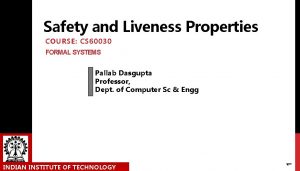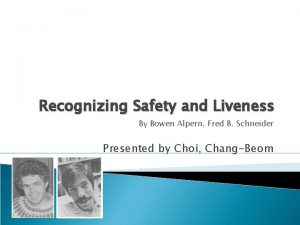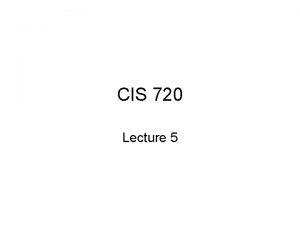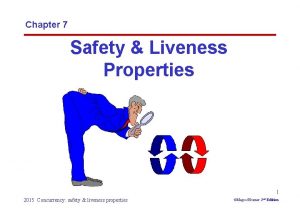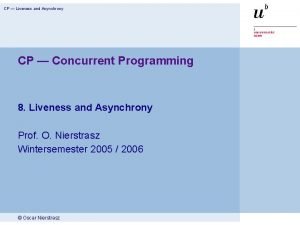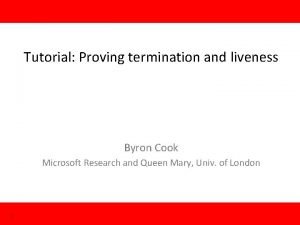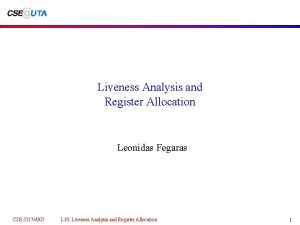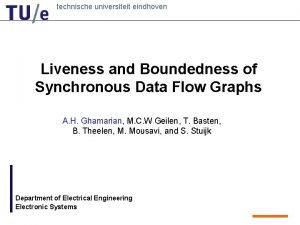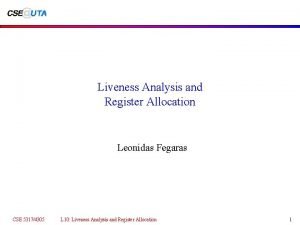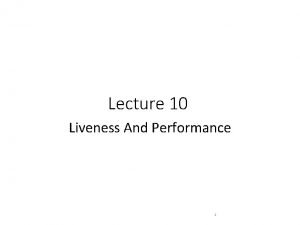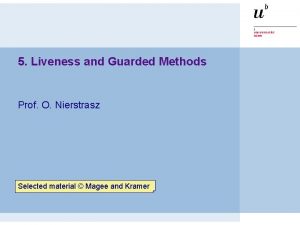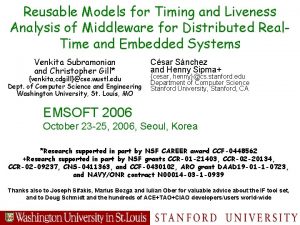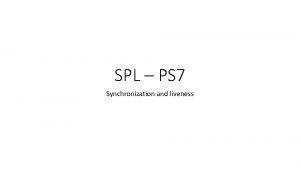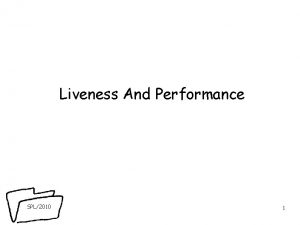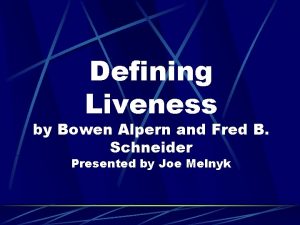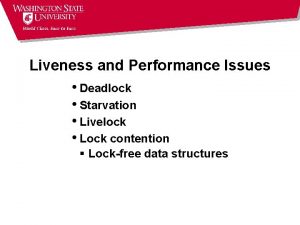Part 3 Safety and liveness Safety vs liveness


























- Slides: 26

Part 3: Safety and liveness

Safety vs. liveness Safety: something “bad” will never happen Liveness: something “good” will happen (but we don’t know when)

Safety vs. liveness for sequential programs Safety: the program will never produce a wrong result (“partial correctness”) Liveness: the program will produce a result (“termination”)

Safety vs. liveness for sequential programs Safety: the program will never produce a wrong result (“partial correctness”) Liveness: the program will produce a result (“termination”)

Safety vs. liveness for state-transition graphs Safety: those properties whose violation always has a finite witness (“if something bad happens on an infinite run, then it happens already on some finite prefix”) Liveness: those properties whose violation never has a finite witness (“no matter what happens along a finite run, something good could still happen later”)

This is much easier. Safety: the properties that can be checked on finite executions Liveness: the properties that cannot be checked on finite executions (they need to be checked on infinite executions)

Example: Mutual exclusion It cannot happen that both processes are in their critical sections simultaneously.

Example: Mutual exclusion It cannot happen that both processes are in their critical sections simultaneously. Safety

Example: Bounded overtaking Whenever process P 1 wants to enter the critical section, then process P 2 gets to enter at most once before process P 1 gets to enter.

Example: Bounded overtaking Whenever process P 1 wants to enter the critical section, then process P 2 gets to enter at most once before process P 1 gets to enter. Safety

Example: Starvation freedom Whenever process P 1 wants to enter the critical section, provided process P 2 never stays in the critical section forever, P 1 gets to enter eventually.

Example: Starvation freedom Whenever process P 1 wants to enter the critical section, provided process P 2 never stays in the critical section forever, P 1 gets to enter eventually. Liveness

Example: Starvation freedom Whenever process P 1 wants to enter the critical section, provided process P 2 never stays in the critical section forever, P 1 gets to enter eventually. Liveness

LTL (Linear Temporal Logic) -safety & liveness -linear time [Pnueli 1977; Lichtenstein & Pnueli 1982]

LTL Syntax : : = a | | | | U

LTL Model infinite trace t = t 0 t 1 t 2. . . (sequence of observations)

q 1 a a, b b q 2 Run: q 3 q 1 q 3 q 1 q 2 Trace: a b a a, b

Language of deadlock-free state-transition graph K at state q : L(K, q) = set of infinite traces of K starting at q (K, q) |= iff for all t L(K, q), t |= (K, q) |= iff exists t L(K, q), t |=

LTL Semantics t |= a iff a t 0 t |= iff t |= and t |= iff not t |= iff t 1 t 2. . . |= t |= U iff exists n 0 s. t. 1. for all 0 i < n, ti ti+1. . . |= 2. tn tn+1. . . |= (K, q) |= iff (K, q) |=

Defined modalities X next U U until = true U F eventually = G always W = ( U ) W waiting-for (weak-until)

Important properties Invariance a safety (pc 1=in pc 2=in) Sequencing a. Wb. Wc. Wd safety (pc 1=req (pc 2 in) W (pc 2=in) W (pc 2 in) W (pc 1=in)) Response (a b) (pc 1=req (pc 1=in)) liveness

Composed modalities a infinitely often a a almost always a

Example: Starvation freedom Whenever process P 1 wants to enter the critical section, provided process P 2 never stays in the critical section forever, P 1 gets to enter eventually. (pc 2=in (pc 2=out)) (pc 1=req (pc 1=in))

State-transition graph Q set of states {q 1, q 2, q 3} A set of atomic observations {a, b} Q Q transition relation q 1 q 2 [ ]: Q 2 A observation function [q 1] = {a}

(K, q) |= Tableau construction (Vardi-Wolper) (K’, q’, BA) where BA K’ Is there an infinite path starting from q’ that hits BA infinitely often? Is there a path from q’ to p BA such that p is a member of a strongly connnected component of K’?

dfs(s) { add s to dfs. Table for each successor t of s if (t dfs. Table) then dfs(t) if (s BA) then { seed : = s; ndfs(s) } } ndfs(s) { add s to ndfs. Table for each successor t of s if (t ndfs. Table) then ndfs(t) else if (t = seed) then report error }
 Safety and liveness in concurrency
Safety and liveness in concurrency Safety liveness
Safety liveness Safety liveness
Safety liveness Eecs483
Eecs483 Liveness
Liveness Addition symbol
Addition symbol Part to part ratio definition
Part to part ratio definition Part part whole
Part part whole What is a technical description?
What is a technical description? Bar
Bar The phase of the moon you see depends on ______.
The phase of the moon you see depends on ______. Part to part variation
Part to part variation Laboratory safety rules and symbols
Laboratory safety rules and symbols Safety depth formula in ecdis
Safety depth formula in ecdis Safety care behavioral safety training
Safety care behavioral safety training Process safety vs personal safety
Process safety vs personal safety Safety assessment for ind safety reporting
Safety assessment for ind safety reporting Basic safety orientation
Basic safety orientation Construction site safety orientation
Construction site safety orientation Tybalt act 1
Tybalt act 1 Fixed and and fixed or is part of which pld?
Fixed and and fixed or is part of which pld? Octave and sestet are the parts of
Octave and sestet are the parts of Abcdef is a regular hexagon with centre o
Abcdef is a regular hexagon with centre o The odyssey and epic poetry an introduction part 1
The odyssey and epic poetry an introduction part 1 Triangle congruence by asa and aas quiz part 1
Triangle congruence by asa and aas quiz part 1 The odyssey and epic poetry: an introduction, part 1
The odyssey and epic poetry: an introduction, part 1 Ken price vink
Ken price vink
